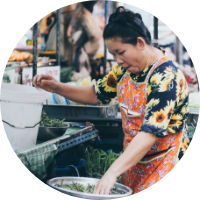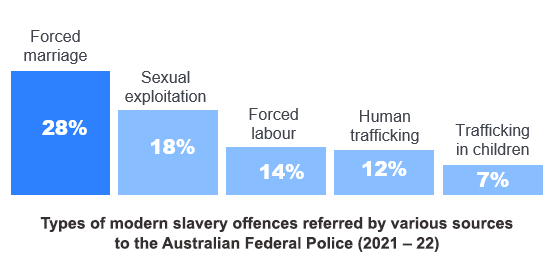Modern Slavery
Today, 49.6 million people live in modern slavery.
Slavery is often hidden in homes, in restaurants, on farms and on building sites. What is common to all of these examples, is that someone is being exploited and controlled.
Modern Slavery in Numbers

49.6 million people live in slavery globally

22 million victims of forced marriage
27.6 million people in forced labour
42 million people exploited in global supply chains in the private economy
3.9 million people in forced labour imposed by state authorities

6.3 million people in forced sexual exploitation
Types of Modern Slavery
Modern slavery is an umbrella term that is used to describe human trafficking, slavery and slavery-like practices.

Human trafficking

Slavery

Servitude

Forced Labour

Debt Bondage

Deceptive recruitment for labour or services

Forced Marriage

Worst forms of child labour
Why does Modern Slavery occur?
Poverty: Although significant progress has been made to reduce global poverty rates, today more than 780 million people live below the international poverty line. Poverty encompasses more than a lack of income. Its manifestations include hunger, malnutrition, limited access to education and other basic services. Those who are marginalised and excluded are particularly susceptible to abuse.
Discrimination and marginalisation: Women, children, migrants and refugees, ethnic and religious minorities often face discrimination and are vulnerable to enslavement. At particular risk are those fleeing war and armed conflict.
Civil disruption and armed conflict: The instability caused by armed conflict can displace communities and expose communities to extreme harm and exploitation, including forced labour networks. Already marginalised groups are particularly at risk fleeing war and armed conflict.
Weak rule of law and impunity: Slavery thrives in contexts where there is the law enforcement system is weak or absent. In some cases, slavery is supported by the local authorities and police. Legal frameworks require enforcement to ensure that human traffickers do not operate with impunity.
Natural disasters: Natural disasters can displace communities and increase the desperation of marginalised groups. Traffickers prey upon displaced people. In dire situations, displaced people are often vulnerable to false offers and are forced to seek out perilous employment.
Slavery in Australia
Over 1,900 people in Australia are victims of modern slavery
Only 1 in 5 victims are detected in Australia


Anyone can be vulnerable to modern slavery. However, some groups are more vulnerable than others. Women and children, people on temporary visas, backpackers, international students, people seeking asylum, and migrants on limited working visas, are particularly vulnerable.
In 2021 alone, Anti-Slavery Australia helped over 400 people who had been trafficked to or from Australia, or had faced modern slavery while in Australia, including forced marriage, servitude and forced labour.
But this is just the tip of the iceberg. In Australia, only 1 in 5 victims of slavery are identified. That means that 80% of victims do not get the support they need and remain in slavery in Australia. And this means that the cases we see are likely to be a small proportion of the scale of modern slavery in Australia.
Faces of Modern Slavery in Australia
Case Studies
Here are real world examples, with names of individuals and businesses changed, to explain the different kinds of exploitation seen by Anti-Slavery Australia and considered in Australian courts.
Jai’s Story
Anti-Slavery Australia | Forced Labour, Human Trafficking, Survivors’ Stories
Maria’s Story
Anti-Slavery Australia | Human Trafficking, Forced Labour, Survivors’ Stories
Abdul’s Story
Anti-Slavery Australia | Forced Labour, Modern Slavery, Survivors’ Stories
Who is at risk?
Women
Children
Refugees and People Seeking Asylum
Migrants
Occupations with Low Visibility or Legal Protection
What are the signs?
- Controlled or restricted freedom of movement – monitored, guarded or confined
- Intimidation and threats including threats of deportation
- Threatened or actual physical and/or sexual violence
- Travel or other important documents have been taken by employer or a third party
- Abusive living and/or working conditions
- Living at the workplace or another place owned/controlled by employer
- Isolation – geographic, social and/or linguistic
- Withholding, underpayment or no payment of wages
- Excessive hours of work
- Debt bondage (i.e. labour or services are provided as security or repayment of an inflated debt)
- Deceived or lack of information about nature and conditions of work
- No discretion over life decisions
- Unable to end employment at any time
What to do if you suspect slavery
You should be careful that any actions you take do not harm a victim or survivor of modern slavery. Never publicly disclose personal information without informed consent.
In emergencies, where there is immediate danger, or where the situation involves a child, call Triple 0 (000).
Anti-Slavery Australia can provide access to free and confidential legal and migration advice to anyone in modern slavery. Call 02 9514 8115 or visit www.antislavery.org.au
To report modern slavery in Australia call the Australian Federal Police on 131 237 or report through their website www.afp.gov.au
Frequently Asked Questions
Does slavery happen more in some parts of Australia than in others?
Slavery occurs in every state of Australia, in rural and urban areas. It is important to be aware that slavery is just as likely to happen anywhere.


